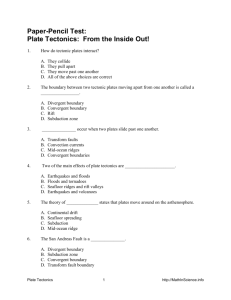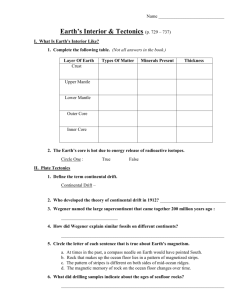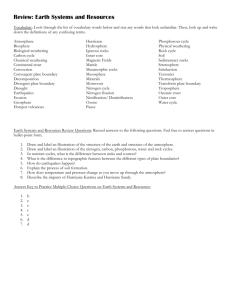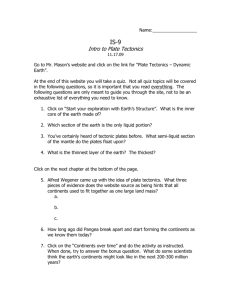Plate Tectonics Gizmo
advertisement
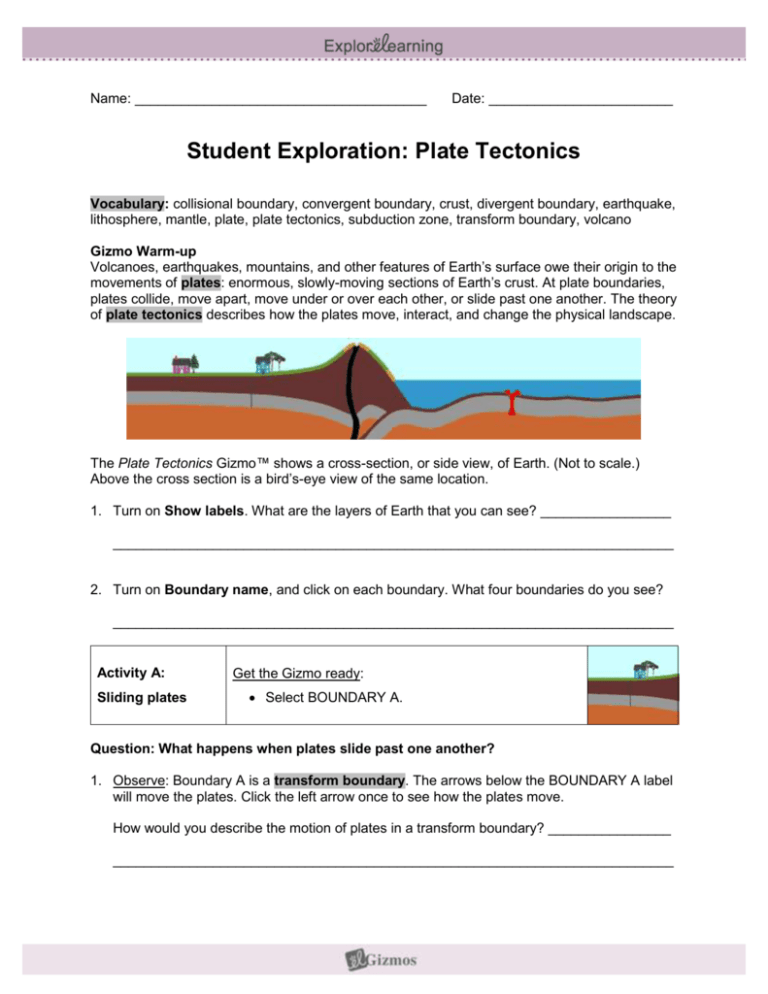
Name: ______________________________________ Date: ________________________ Student Exploration: Plate Tectonics Vocabulary: collisional boundary, convergent boundary, crust, divergent boundary, earthquake, lithosphere, mantle, plate, plate tectonics, subduction zone, transform boundary, volcano Gizmo Warm-up Volcanoes, earthquakes, mountains, and other features of Earth’s surface owe their origin to the movements of plates: enormous, slowly-moving sections of Earth’s crust. At plate boundaries, plates collide, move apart, move under or over each other, or slide past one another. The theory of plate tectonics describes how the plates move, interact, and change the physical landscape. The Plate Tectonics Gizmo™ shows a cross-section, or side view, of Earth. (Not to scale.) Above the cross section is a bird’s-eye view of the same location. 1. Turn on Show labels. What are the layers of Earth that you can see? _________________ _________________________________________________________________________ 2. Turn on Boundary name, and click on each boundary. What four boundaries do you see? _________________________________________________________________________ Activity A: Sliding plates Get the Gizmo ready: Select BOUNDARY A. Question: What happens when plates slide past one another? 1. Observe: Boundary A is a transform boundary. The arrows below the BOUNDARY A label will move the plates. Click the left arrow once to see how the plates move. How would you describe the motion of plates in a transform boundary? ________________ _________________________________________________________________________ 2. Sketch: Draw a bird’s-eye view of the plate boundary before and after the plate motion. Draw an arrow to show which way the plate moved. Before movement After movement 3. Locate: Turn on Show location. Where on Earth can you find this type of boundary? (Note: You can refer to a world map or atlas for location names.) _________________________________________________________________________ Highlight these locations on the map below. Activity B: Colliding continents Get the Gizmo ready: Turn off Boundary name and Show location. Select BOUNDARY B. Question: What happens when two continents collide? 1. Observe: Boundary B is an example of a convergent boundary, where two plates are moving toward one another. When the two plates both contain continental crust, it is called a collisional boundary. Click the left arrow four times to see how the plates move. How would you describe the motion of plates in a collisional boundary? ________________ _________________________________________________________________________ 2. Sketch: Draw a side view of the plate boundary before and after the plate motion. Draw an arrow to show which way the plate moved. Before movement After movement 3. Locate: Turn on Show location. Where on Earth can you find this type of boundary? (Note: You can refer to a world map or atlas for location names.) _________________________________________________________________________ Highlight these locations on the map below. Activity C: Oceanic crust meets continental crust Get the Gizmo ready: Turn off Boundary name and Show location. Select BOUNDARY C. Question: What happens when ocean crust collides with continental crust? 1. Observe: Boundary C is another type of convergent boundary called a subduction zone. Click the left arrow four times to see how the plates move. How would you describe the motion of plates in a subduction zone? ___________________ _________________________________________________________________________ 2. Sketch: Draw a side view of the plate boundary before and after the plate motion. Draw an arrow to show which way the plate moved. Before movement After movement 3. Locate: Turn on Show location. Where on Earth can you find this type of boundary? (Note: You can refer to a world map or atlas for location names.) _________________________________________________________________________ Highlight these locations on the map below. Activity D: Spreading plates Get the Gizmo ready: Turn off Boundary name and Show location. Select BOUNDARY D. Question: How is new crust formed? 1. Observe: Boundary D is a divergent boundary. Click the right arrow four times to see how the plates move. How would you describe the motion of plates in a divergent boundary? ________________ _________________________________________________________________________ 2. Sketch: Draw a side view of the plate boundary before and after the plate motion. Draw an arrow to show which way the plate moved. Before movement After movement 3. Locate: Turn on Show location. Where on Earth can you find this type of boundary? (Note: You can refer to a world map or atlas for location names.) _________________________________________________________________________ Highlight these locations on the map below.

